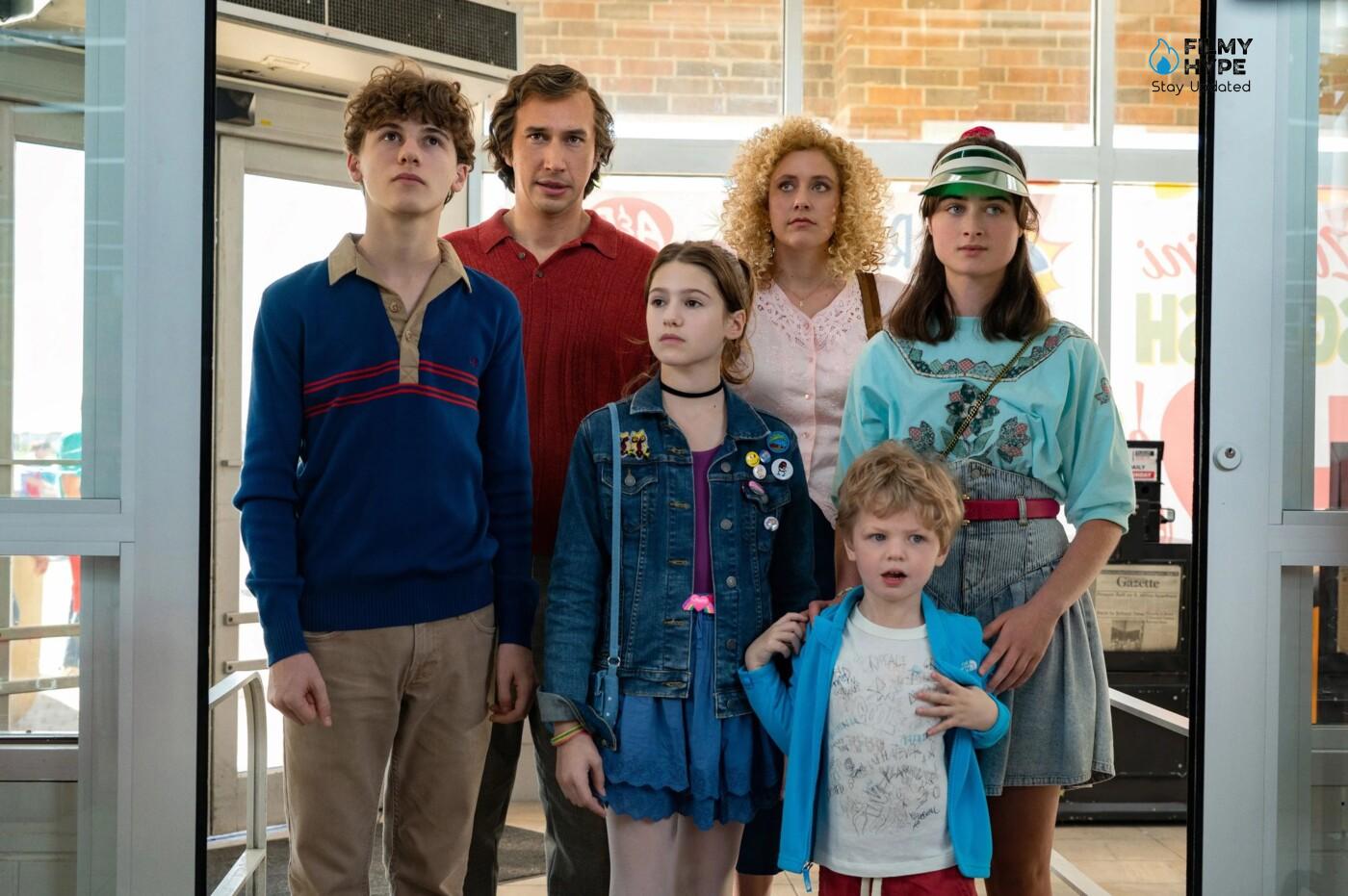White Noise Ending Explained: What Happened to Jack and Babette?
Based on the homonymous novel written by Don DeLillo that came to light in 1985, White Noise is a Netflix movie Directed by Noah Baumbach, who was also behind Marriage Story, a film that got six Oscar nominations. The dramatic comedy that premiered on December 30, 2022, follows Jack Gladney (Adam Driver) a professor of “Hitler studies” at the fictional College on the Hill who leads a calm and carefree lifestyle, because he is highly respected and admired at the institution, and has a happy family with Babette (Greta Gerwig). This is their fourth marriage for both of them and they have four children in total. However, Babette hides a secret that her eldest daughter intends to discover, also after a toxic accident, they have to deal with the universal mysteries of love, death and the possibility of achieving happiness in an uncertain world.

Noah Baumbach has returned to Netflix, the place where the general public met him through Marriage Story, although he had already been one of the authors most followed by critics for years. Baumbach, however, has not used the convenience of the platform to make his cinema more accessible. Rather the complete opposite. He has dared to make his first adaptation (instead of his own classic and acclaimed scripts) of a novel considered, like almost all of Don DeLillo’s work, unadaptable.
The truth is that White Noise is wonderfully starring Adam Driver, always stellar, and the director’s wife, the director, screenwriter, and (logically) actress, Greta Gerwig. The film takes us to a suburban neighborhood of the eighties where a wealthy and intellectual family suffers from an existential paranoia that leads to increasingly surreal events. The truth is that the events of the film seem to coexist between reality and delusion, leading its characters to walk between satire and surrealism. With such ingredients, it is logical that more than one viewer has been somewhat stunned after reaching the credits. For all those who need a review, this article goes.
White Noise: Plot Summary
Death is scary or rather, it is the thought of this that constantly wears down the protagonists of Baumbach. Jack and Babette Gladney have found each other after a series of unfortunate marriages and lead a rather extravagant existence: the four children Denise, Arlo, Elliot and Heinrich are brothers, coming from different marriages but united on a character level. Paranoia reigns supreme in the Gladney family, does not leave even the youngest immune, but has a different effect for age: in siblings, it becomes ingenuity and curiosity, in adults, it foments the terror of not leaving a mark, both from a private and a professional point of view.
There is only one way to survive death: to become an icon. “Musical” emperors, like Elvis, or politicians – according to Jack‘s point of view pioneers of Hitler‘s studies – imperishable flowers of consent, forced or not, who survive the processes of creation and disintegration. There is no accident, natural catastrophe, or conspiracy, which could undermine the substantial studies of the two professors. But teaching stops at the university; at home, it is the children who ask, to pick up the negative signs of an illness that is insinuating itself both within a family unit and in the geographical space. Jack knows everything about Hitler, but little about his children.

Babette lives in a world completely apart: the two members of the couple try in every way to find a foothold, a shortcut to avoid the intrusive thought par excellence, that of not having enough time. And it is here that Baumbach offers us greater intensity from the point of view of writing, “sister” of the wonderful Story of a Marriage: slipping into the maze of an emotional drama, of a mental circumscription that becomes extremely material, tactile, even taking on the physical form: that of a white pill, with an uncertain composition, which contains the deafening noise of shattered psychologies, those of men who profess to be great communicators, but in reality lose their vigor precisely in the effort of confessing that something is wrong.
White Noise Ending Explained: What Happened At The End Of White Noise?
Although Babette’s eldest daughter warns Jack that something is wrong with her mother, the protagonist of White Noise refuses to believe that it is something really serious and decides to confide in his wife when she tells him that he has nothing to worry about. A toxic accident forces the family to leave their home and go to a shelter. On the way, the professor manages to see his wife ingest something, but when he questions her about it, she assures him that it was just candy. Due to the situation, Jack prefers not to insist. After a few days, they return home, but Jack discovers that the time he was exposed to the toxic rain probably shortened his lifespan, which begins to haunt him. Although he visits the doctor repeatedly, he omits the event that exacerbated his fear of death.
White Noise is a film that navigates between genres and whose tone varies between the different events in the film. First, we have a rather slow and intellectual section in which we learn about the university work of the protagonist, Jack Gadney (Adam Driver) an expert in Hiler, and his wife, a monitor of different activities, Babette (Greta Gerwig). The tape does not take long to fill with small comic situations through the five children (four from previous marriages) of the family, the doubts of the protagonist as he is an expert on Hitler who does not speak German, or the character of Don Cheadle, who wants to become on an eminence in Elvis.
The drama and mystery that will make up the last part begin when Babette’s eldest daughter discovers that her mother is taking some mysterious pills that affect her memory, something that she flatly denies. However, the film turns into a catastrophe thriller as a toxic cloud arrives, forcing the family to leave their home behind and join a panicked crowd. The main character, Jack, is exposed to the cloud by having to get out of the car to get gas, leaving him already worried about unknown long-term side effects. All the while his wife’s affair with pills worsens, appearing depressed and almost unbalanced.

Babette confesses that the pills were part of an experimental study to combat the fear of death. When they locked her out of it, to continue having access to the pills, Babette began going to a seedy hotel to have sex with the drug lord (nicknamed Gray) in exchange for her dose of pills. Jack does not let the offense to his wife go by and after locating the guy and the motel through the newspaper, he goes there to kill Gray, but also to seek help to escape from his fear of dying. Despite firing two shots at the pathetic guy she meets, Babette arrives in time to stop the matter and, as a bonus, is shot by Gray who lightly knocks both of them out.
The strange trio ends up in a kind of hospital run by a German atheist nun, who refuses to give them the slightest hope of life through religion. In the end, the couple has no choice but to get back together as the only way out of that constant fear of death, the true plot of the film. Everything else has been little excuses to reveal a strange balance. On the one hand, we cannot live in fear of dying constantly and, on the other, we can die at any moment, so how the hell not to be afraid? The final scene emphasizes the consumerist alienation of the people, Americans in this case, in the supermarket. After all, taking refuge in the opium of routine is, perhaps, the best way to escape fear. The film ends, nothing less, with a flash mob in the middle of the macro market to dismiss this fable.
Why Does Babette Take So Many Pills?
When Babette’s eldest daughter finds the pills her mother is hiding, she asks Jack to find out more about them. After learning that it is a strong drug that is not yet for sale, Adam Driver’s character confronts his wife, who has no choice but, to tell the truth. Because her irrational fear of death did not allow her to have a happy life, she enrolled in an experimental trial of a drug. The studies failed, so Babette began exchanging sex with the mysterious Mr. Gray in exchange for the drug called Dylar. However, she stopped taking it because he confused her and made her forgetful.
How Did Jack Deal with His Fear of Death?
Although Jack insists on knowing the name of the man his wife cheated on him with, Babette prefers not to reveal it for fear that her husband will decide to hunt for the man to murder him. However, when the professor feels fear of him overpowering him, he desperately searches for a Dylar pill and finds an ad in the newspaper that leads him to the head of the experiment. He meets him at a hotel and although at first, he just wanted to buy some pills, when he heard that he was talking about his wife, he did not hesitate to shoot him. While trying to clean up the crime scene, Mr. Gray picks up the gun and shoots. At that moment, Babette appears and the bullet hits Jack’s hand and his wife’s leg. The spouses react and take Mr. Gray to a hospital, where they too are treated. White Noise ends with Jack and Babette solving their problems and dancing with their family in a supermarket.


